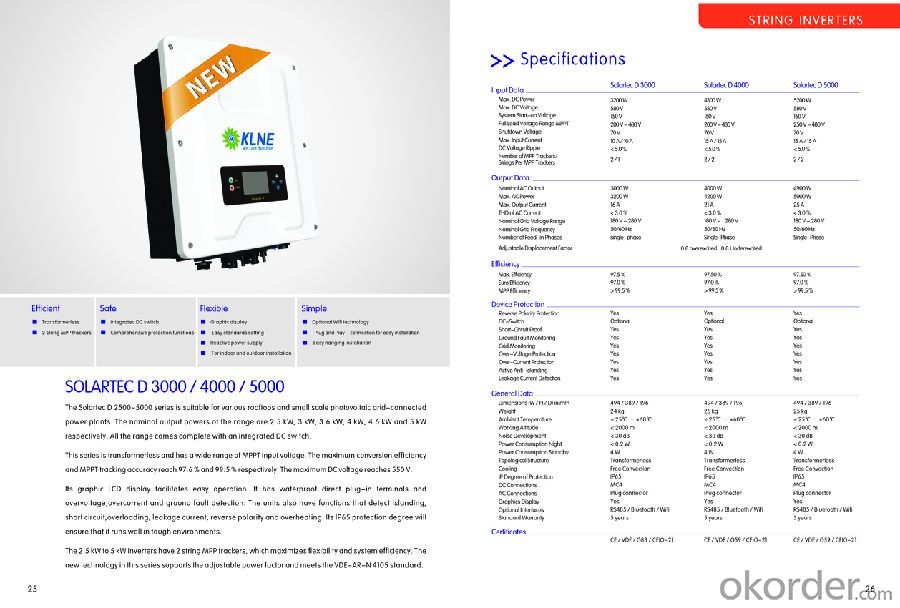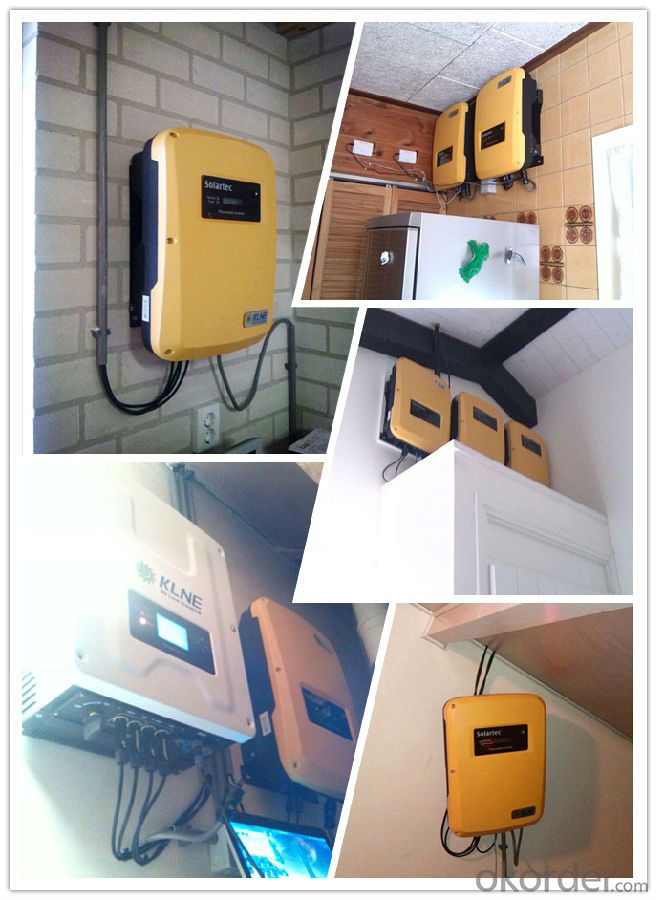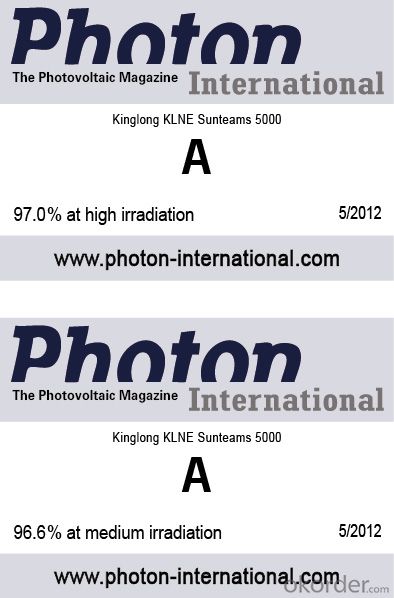Solartec D 4600 on grid inverter with 2 MPPT WIFI
- Loading Port:
- Shanghai
- Payment Terms:
- TT OR LC
- Min Order Qty:
- -
- Supply Capability:
- 10000 set/month
OKorder Service Pledge
Quality Product, Order Online Tracking, Timely Delivery
OKorder Financial Service
Credit Rating, Credit Services, Credit Purchasing
You Might Also Like
Solartec D 2500,3000,3600,4000,4600,5000
2MPPT Trackers
online monitoring system by integrated WIFI
Integrated DC Switch
Comprehensive protection functions
Graphic display
High efficiency 97.5%
RS 485/RS 232/SolarLog Communication
5 Years warranty
G83,G59,VDE 4105,VDE 0126,CEI





Beijing Kinglong New Energy Technology Co., Ltd.
3rd. floor, Caihong North Building West Entrance, 11 Xinxi Road, Shang Di, Haidian Dist, Beijing, China
T.:+86(0)1062988159-678 M.: +86 1800 1179 441
Skype:klnevivian
Skype:klnevivian
E:vivian@kinglongpower.com
Website: www.kinglongpower.com
- Q:What is the power factor of a solar inverter?
- The power factor of a solar inverter is a measure of how effectively it converts the DC power generated by solar panels into AC power that can be used by electrical devices. A high power factor indicates efficient conversion, while a low power factor signifies energy losses.
- Q:How does a solar inverter handle voltage and frequency variations caused by grid faults?
- A solar inverter is designed to handle voltage and frequency variations caused by grid faults through a process known as grid support or anti-islanding function. When a grid fault occurs, such as a sudden drop in voltage or frequency, the solar inverter detects the disturbance and responds accordingly. To handle voltage variations, the solar inverter typically incorporates a voltage control mechanism. It monitors the grid voltage continuously and adjusts its own output voltage to match the grid voltage level. In the event of a voltage drop or spike caused by a grid fault, the inverter adjusts its output voltage accordingly to maintain a stable and safe operating condition. This helps protect both the solar system and the grid from potential damage. Similarly, the solar inverter also deals with frequency variations caused by grid faults. It constantly monitors the grid frequency and adjusts its own output frequency to match the grid frequency. If a grid fault results in a sudden change in frequency, the inverter responds by adjusting its own frequency accordingly. This ensures that the solar system remains synchronized with the grid and continues to supply power without disruptions. Additionally, solar inverters are equipped with anti-islanding protection, which means they are designed to quickly disconnect from the grid in the event of a grid fault. This is a safety measure to prevent the solar system from continuing to supply power to a faulty grid, which could pose a risk to utility workers trying to repair the fault. Overall, a solar inverter's ability to handle voltage and frequency variations caused by grid faults is crucial for the safe and efficient operation of a solar power system. By continuously monitoring the grid conditions and adjusting its output accordingly, the inverter ensures that the solar system remains in sync with the grid and provides stable and reliable power.
- Q:What is the role of reactive power injection in a solar inverter?
- The role of reactive power injection in a solar inverter is to improve power factor and stabilize the voltage in the electrical grid. By injecting reactive power, the inverter helps balance out the reactive power demand from other loads in the grid, reducing the strain on the system and ensuring efficient power transfer. This helps maintain grid stability and prevents voltage fluctuations, ultimately enhancing the overall performance and reliability of the solar power system.
- Q:What is the purpose of a solar inverter?
- The purpose of a solar inverter is to convert the direct current (DC) electricity produced by solar panels into alternating current (AC) electricity that can be used to power household appliances and be fed back into the electrical grid.
- Q:PV grid-connected inverter and independent inverter in the control of what is the difference
- The independent inverter in the output voltage phase amplitude of the frequency control is initially set good. Independent inverter, you should refer to off-grid inverter, do not need to consider the grid situation.
- Q:What is the role of a solar inverter in a solar-powered ventilation system?
- The role of a solar inverter in a solar-powered ventilation system is to convert the direct current (DC) electricity produced by the solar panels into alternating current (AC) electricity that can be used to power the ventilation system. The inverter ensures that the electricity generated by the solar panels is compatible with the electrical requirements of the ventilation system, enabling it to operate efficiently and effectively.
- Q:Can a solar inverter be used in commercial applications?
- Yes, a solar inverter can be used in commercial applications. In fact, solar inverters are commonly used in commercial settings to convert the direct current (DC) produced by solar panels into alternating current (AC) that can be used to power various electrical devices and appliances. Commercial buildings often have larger solar systems installed, requiring more powerful inverters to efficiently convert the solar energy into usable electricity for the facility's commercial operations.
- Q:What is the efficiency rating of a solar inverter?
- The efficiency rating of a solar inverter refers to the percentage of solar energy that is converted into usable electricity. It is a measure of how effectively the inverter can convert the direct current (DC) output from the solar panels into alternating current (AC) electricity that can be used to power household appliances or be fed back into the grid. The higher the efficiency rating, the more efficient the inverter is at converting solar energy into electricity.
- Q:Can a solar inverter be used with solar-powered water pumps?
- Yes, a solar inverter can be used with solar-powered water pumps. A solar inverter converts the DC power generated by solar panels into AC power, which is suitable for running various electrical devices, including water pumps. This allows the solar panels to directly power the water pump, enabling it to operate efficiently using renewable energy from the sun.
- Q:Can a solar inverter be used in mobile or portable solar systems?
- Yes, a solar inverter can be used in mobile or portable solar systems. In fact, they are essential components of such systems as they convert the DC power generated by solar panels into AC power that can be used to power various devices and appliances. Portable solar systems often include built-in inverters to enable convenient and efficient use of solar energy on the go.
1. Manufacturer Overview |
|
|---|---|
| Location | |
| Year Established | |
| Annual Output Value | |
| Main Markets | |
| Company Certifications | |
2. Manufacturer Certificates |
|
|---|---|
| a) Certification Name | |
| Range | |
| Reference | |
| Validity Period | |
3. Manufacturer Capability |
|
|---|---|
| a)Trade Capacity | |
| Nearest Port | |
| Export Percentage | |
| No.of Employees in Trade Department | |
| Language Spoken: | |
| b)Factory Information | |
| Factory Size: | |
| No. of Production Lines | |
| Contract Manufacturing | |
| Product Price Range | |
Send your message to us
Solartec D 4600 on grid inverter with 2 MPPT WIFI
- Loading Port:
- Shanghai
- Payment Terms:
- TT OR LC
- Min Order Qty:
- -
- Supply Capability:
- 10000 set/month
OKorder Service Pledge
Quality Product, Order Online Tracking, Timely Delivery
OKorder Financial Service
Credit Rating, Credit Services, Credit Purchasing
Similar products
New products
Hot products
Hot Searches
Related keywords





























